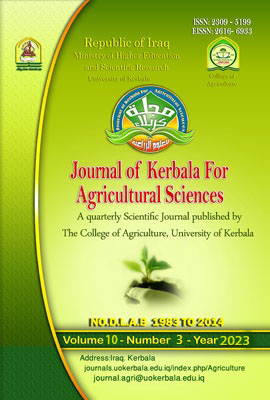Effect of UV-C Rays in Entomopathogenic Fungi Beauveria bassiana (Bals.) to Control Apple Fruit Moth Cydia pomonella L. (Tortricidae: Lepidoptera)
DOI:
https://doi.org/10.59658/jkas.v10i3.1237Keywords:
Codling moth, biological control, Entomopathogenic fungiAbstract
The study was conducted to investigate the behaviour and development of the entomopathogenic fungus Beauveria bassiana exposed to UV-C rays and exposure periods under laboratory conditions in pupae of the apple moth Cydia pomonella L. The results indicated that fungus exposed to UV-C rays for 5 minutes became more effective in controlling moths, compared with concentrations (2.25× 104, 105, 106 and 107 spore/ml) of fungus exposed to UV-C rays for 10 minutes. The results also showed that pupae and insects emerging from them at the age of (1-2) days were more sensitive to fungus concentrations than pupae at the age of (10-12). As the percentage of emergence decreased, with the increase in fungus concentrations. Furthermore, the levels of proteins in the blood for insects produced from pupae aged (1-2) and (10-12) days decreased to 8.30 and 16.10 µg/ml ,respectively, when were exposed to the irradiated fungus B. bassiana for 5 minutes at a concentration of 2.25x107 spores/ml. Compared to insects produced from pupae exposed to non-irradiated pathogenic fungi, that was 20.12 and 25.15 µg/ml, respectively, and in comparison with insects produced from pupae exposed to the fungus for 10 minutes at the age of (1-2) and (10-12) days, respectively, as it reached 12.50 and 26.10 µg/ml and for the same concentration. In addition to a decrease in the levels of sugars in the blood, reaching 20.00 and 24.00 ml/ µg in insects produced from pupae aged (1-2) and (10-12) days, respectively, exposed to the irradiated fungus for 5 minutes and with the same concentration. The percentages of blood components decreased quantitatively and qualitatively, as the number of hemocytes for insects that emerged from pupae exposed to the irradiated fungus for 5minutes reached 70 and 95 cells/ml, respectively, compared to 92 and 110 cells/ml for insects that emerged from pupae exposed to the irradiated fungus for 10minutes and with the same concentration.
Downloads
Published
How to Cite
Issue
Section
License
Copyright (c) 2023 Copyright (c) 2024 is the Author's article. Published by the Journal of Kerbala for Agricultural Sciences under a CC BY 4.0 license

This work is licensed under a Creative Commons Attribution 4.0 International License.
Licensing Terms
All articles are published under a Creative Commons License and will be directed to the Creative Commons Attribution 4.0 International License (CC BY 4.0) That permits use, distribution, and reproduction in any medium, provided the original work is properly cited. This license also allows the work to be used for commercial purposes.
Use by both non-commercial and commercial users
This content is licensed under a Creative Commons Attribution 4.0 International (CC BY 4.0) license, permitting use by both non-commercial and commercial users. Individual users may access, download, copy, display, and redistribute the articles to colleagues, as well as adapt, translate, and text- and data-mine the content, subject to the following conditions:
- The author's moral rights, including the right of attribution and the right to protect their work from derogatory treatment, are respected.
- Where content in the article is identified as belonging to a third party, users must ensure that any reuse complies with the copyright policies of the owner of that content.
- If the article content is reused for research or educational purposes, users should maintain a link to the appropriate bibliographic citation, including the DOI and a link to the published version on the journal's website.






